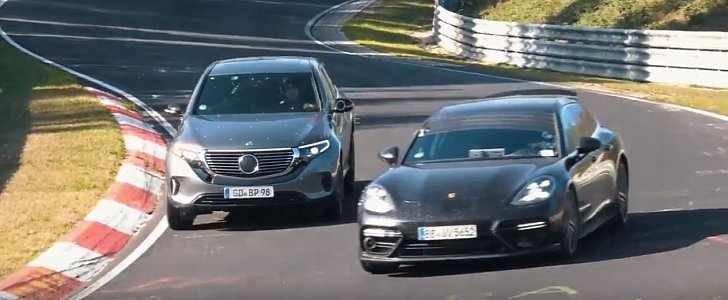With a course of 20.8 kilometers (12.9 miles), the Nurburgring might be the world's longest racetrack, but, at times, the Green Hell simply isn't big enough for two cars. And the two machines we want to feature today are the 2020 Mercedes-Benz EQC and the Porsche Panamera Turbo S E-Hybrid.
Sure, both models are already present in the real world (the Panny has been with us for a while, while the electric Benz just landed last month), but it's not uncommon for automotive producers to continue testing after a model has made its official debut.
As you can imagine, when the 680 horsepower gas-electric Porscha, which came in Sport Turismo form, came across the 407 horsepower crossover, the first didn't waste any time for its pass maneuver.
Now, we've already shown you the Porsche Panamera Turbo S E-Hybrid on multiple occasions (here's a circuit attack involving the gas-electric Zuffenhausen toy), which is why we'll focus on the all-electric Mercedes.
Each of the EQC's axles is powered by an electric motor, with the combined output mentioned above (the maximum torque sits at 564 lb-ft of twist). Note that the front motor is optimized for efficiency when nothing more than medium loads are required, while the rear unit is there to add go-fast abilities.
Each of them features a single-speed tranny, with the 0 to 60 mph time of the crossover sitting at 4.9 seconds.
The EQC 400, which is the model we get for now, makes use of an 80 kWh lithium-ion battery, which is supplied by Daimler subsidiary Deutsche Accumotive. And while the EPA has yet to rate the vehicle, we're expecting a real-world range of 200 miles.
As for recharging, the EQC can use a 150 kWh DC line, as part of the Combined Charging System standard, which will bring the battery charge to 80 percent in just 40 minutes.
With the EQC marking the debut of the Mercedes-Benz EQ electron juice-sipping range, we can talk about two other known models, namely the EQA compact and the EQS luxury sedan.
As you can imagine, when the 680 horsepower gas-electric Porscha, which came in Sport Turismo form, came across the 407 horsepower crossover, the first didn't waste any time for its pass maneuver.
Now, we've already shown you the Porsche Panamera Turbo S E-Hybrid on multiple occasions (here's a circuit attack involving the gas-electric Zuffenhausen toy), which is why we'll focus on the all-electric Mercedes.
Each of the EQC's axles is powered by an electric motor, with the combined output mentioned above (the maximum torque sits at 564 lb-ft of twist). Note that the front motor is optimized for efficiency when nothing more than medium loads are required, while the rear unit is there to add go-fast abilities.
Each of them features a single-speed tranny, with the 0 to 60 mph time of the crossover sitting at 4.9 seconds.
The EQC 400, which is the model we get for now, makes use of an 80 kWh lithium-ion battery, which is supplied by Daimler subsidiary Deutsche Accumotive. And while the EPA has yet to rate the vehicle, we're expecting a real-world range of 200 miles.
As for recharging, the EQC can use a 150 kWh DC line, as part of the Combined Charging System standard, which will bring the battery charge to 80 percent in just 40 minutes.
With the EQC marking the debut of the Mercedes-Benz EQ electron juice-sipping range, we can talk about two other known models, namely the EQA compact and the EQS luxury sedan.







